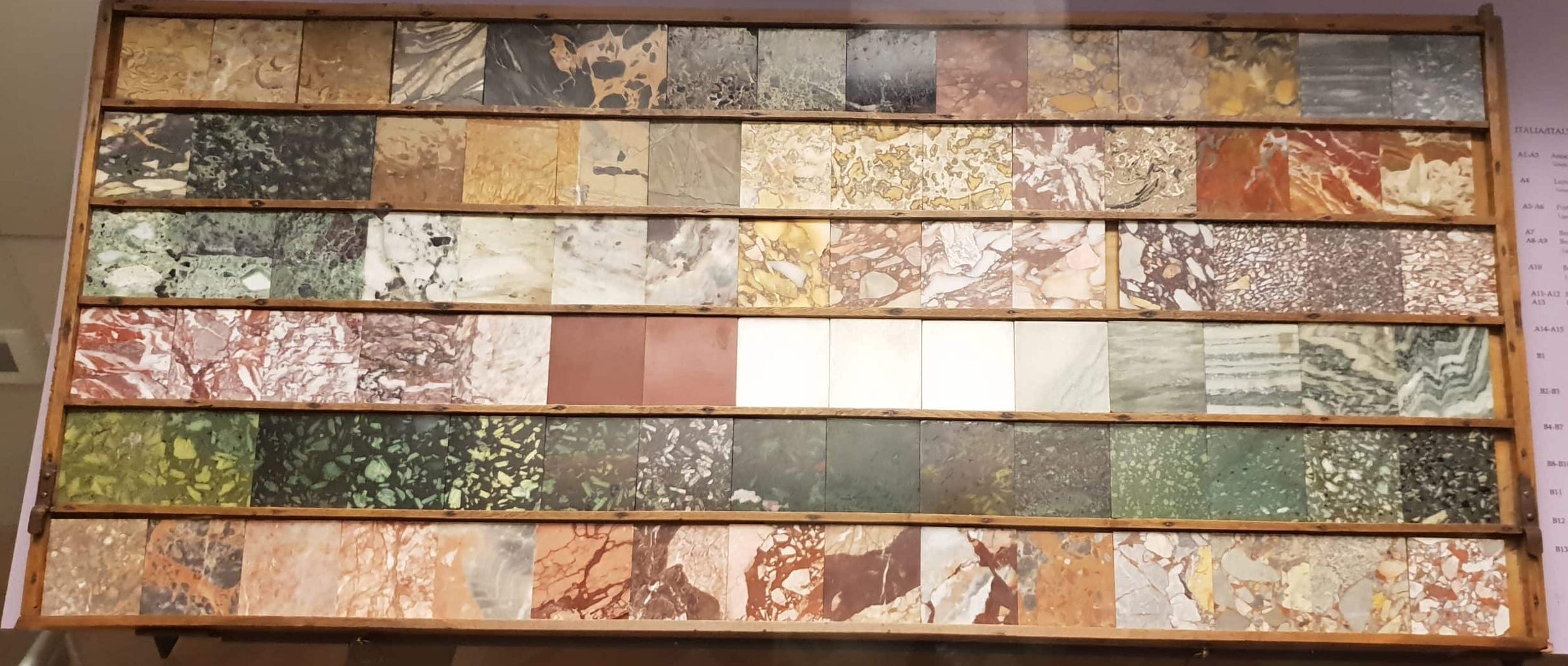Start with our video overview:
Marble is one of the most enduring symbols of Ancient Rome, conjuring images of grand temples, towering columns, and lifelike statues. Prized for its ability to capture intricate detail, marble was the preferred material for the lifelike naturalism that defined Roman art and architecture. Today, when people think of classical antiquity, they often picture gleaming white marble structures and sculptures. While this has some truth to it, it tells only part of the story.
Before the rise of marble, early Roman builders relied on tuff, a porous volcanic rock found near the Seven Hills of Rome and the Alban Hills. Tuff was strong and abundant, making it ideal for the city’s earliest infrastructure projects. One of the best-known examples is the Servian Wall, constructed in the 4th century BCE to fortify Rome after the city’s devastating sack by the Gauls in 390 BCE. For sculpture, early Romans used terracotta. This could be seen in the Temple of Jupiter Optimus Maximus, whose original 6th century BCE cult statue of Jupiter was crafted from baked clay rather than stone.
Rome’s love affair with marble began as its influence spread across the Mediterranean. The Greeks, who had been using marble for statues and temples since the 7th and 6th centuries BCE, set the standard for craftsmanship. As Rome conquered Greece and absorbed its culture, philhellenism (the admiration of Greek art and ideas) became widespread among the Roman elite. The pivotal moment came in 146 BCE, when Rome saw the construction of its first marble temple: the Temple of Jupiter Stator, designed by the Greek architect Hermodorus of Salamis. From that point forward, marble became a defining material in Roman architecture, reaching its peak during the imperial period.
Three types of marble dominated the Roman world: Carrara, Parian, and Pentelic. Carrara marble, quarried in northern Italy, was the most accessible to Rome and became the empire’s go-to material for large-scale projects. It was used in iconic structures such as the Forum of Augustus and Trajan’s Column. Parian marble, sourced from the Greek island of Paros, was prized for its fine grain and luminous quality. Some of the most famous works of classical art, including the Venus de Milo and Winged Victory of Samothrace, were sculpted from this marble. Roman artists also used Parian marble for detailed portraiture, such as the head of the Via Labicana Augustus statue. Meanwhile, Pentelic marble, from Mount Pentelikon in Greece, was used in Athens’ Parthenon and appeared in Roman masterpieces such as the Arch of Titus in the Roman Forum.
One of the biggest misconceptions about marble statues is that they were white. In reality, Greek and Roman sculptures were painted in vibrant colors. Over time, these pigments faded, leaving behind the stark white surfaces that became synonymous with classical beauty. In the early modern period, scholars and collectors embraced this white aesthetic, even going so far as to scrape off any remaining traces of paint to fit their idealized vision of antiquity. Fortunately, modern technology has allowed researchers to detect remnants of ancient pigments. This scientific breakthrough has led to stunning reconstructions, giving us a glimpse of how these statues looked in their time: not as pristine white marble, but as vividly painted works of art.
Bibliography
- Bradley, M. (2006). “Color and Marble in Early Imperial Rome.” The Cambridge Classical Journal, 52, 1–22. http://www.jstor.org/stable/44698291
- Nieset, Lane. (2018). “Visit the Islands Where Most Greek Marble Statues Were Made.” National Geographic. https://www.nationalgeographic.com/travel/article/things-to-do-cyclades-greek-islands-marble
- Nowakowski, Teresa. (2023). “Vibrant Paint Once Decorated the 2,500-Year-Old Parthenon Marbles.” Smithsonian Magazine. https://www.smithsonianmag.com/smart-news/new-research-reveals-the-vibrant-paint-that-once-decorated-the-parthenon-marbles-180983058/
- Solly, Meilan. (2022). “See the Vibrant, Long-Overlooked Colors of Classical Sculptures.” Smithsonian Magazine. https://www.smithsonianmag.com/smart-news/see-the-vibrant-long-overlooked-colors-of-classical-sculptures-180980321/
- Spencer, Edward. (1938). “The Stones Used in the Construction and Decoration of Ancient Rome.” The Classical Journal, 33(5), 271–279. http://www.jstor.org/stable/3290845
This content is brought to you by The American Institute for Roman Culture, a 501(C)3 US Non-Profit Organization.
Please support our mission to aid learning and understanding of ancient Rome through free-to-access content by donating today.
Cite This Page
Cite this page as: Darius Arya, The American Institute for Roman Culture, “Marble in Ancient Rome,” Ancient Rome Live. Last modified 04/12/2025. https://ancientromelive.org/marble/
License
Created by The American Institute of Roman Culture, published on 04/12/2025 under the following license: Creative Commons: Attribution-NonCommercial-ShareAlike. This license lets others remix, tweak, and build upon this content non-commercially, as long as they credit the author and license their new creations under the identical terms. Please note that content linked from this page may have different licensing terms.




